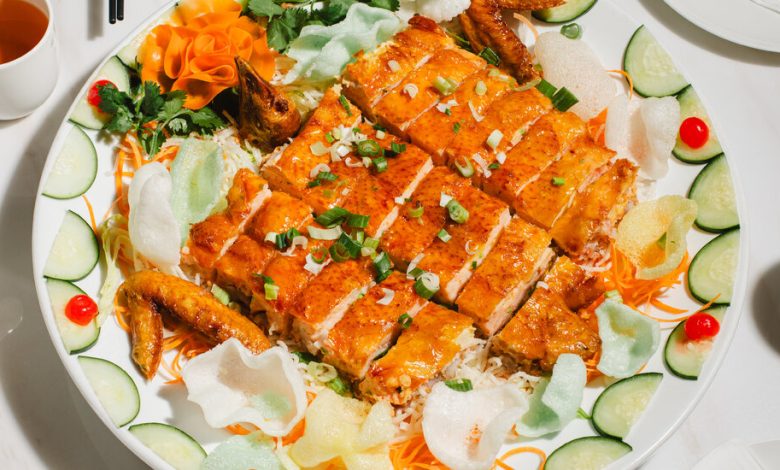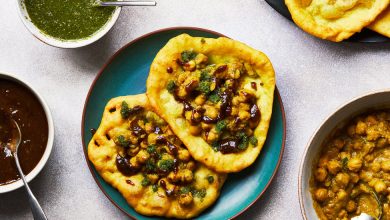Restaurant Review: Hakka Food Makes a Rare Appearance in Chinatown

I have eaten sweet-and-sour pork out of takeout containers on the floor of apartments while moving boxes towered over my head. I have plucked out its pineapple wedges and bell peppers with plastic chopsticks under strings of puffer-fish lights at long-gone Polynesian restaurants in New Jersey. I have eaten sweet-and-sour pork in which sugar and acid were equally matched antagonists, and I’ve eaten it when the sauce looked and tasted like melted lollipops.
Until a few months ago, though, I had never tried sweet-and-sour pork served over ice.
That is how the dish is presented at Hakka Cuisine, a Chinese restaurant that opened about a year ago on Division Street just east of Bowery. Hakka Cuisine makes it without pineapples or peppers, but there are some maraschino cherries and melon balls arranged around the rim of the plate like a halo. Chances are that you have seen sweet-and-sour pork the color of those cherries, tinted by ketchup and, in some cases, red dye. The sauce at Hakka Cuisine contains neither. It is closer to the reddish mahogany of expensive bourbon.
The most remarkable thing about the sauce, though, is that it hardens into something like a candy shell as it sits on the ice cubes. This protects the fried batter on the pork while magnifying its crunchiness, which is already pretty intense. When I tasted the pork in its icy glaze, which had a sugar-acid ratio that reminded me of white balsamic vinegar, I had a strong feeling that the chef, Ming Huang, knows a trick or two.
He does. Cantonese banquet dishes are the backbone of his menu at Hakka Cuisine, war horses like prawns in mayonnaise with candied walnuts, lettuce cups filled with minced chicken and pine nuts, and so on. The kitchen cooks some standards that are becoming difficult to find around Chinatown, including fried squab served with a dish of five-spice salt to bring out the ginger and other aromatics in the pink meat.
There are Hong Kong specialties as well, like the excellent Typhoon Shelter squid that is stuffed with shrimp, fried and scattered with fresh chiles and scallions and a handful of flash-fried garlic.
If this were as far as it went, Hakka Cuisine would still deserve a star on every restaurant fanatic’s map of Chinatown. But as the name suggests, the restaurant has another side. Alongside the Cantonese food on the menu are dishes that are traditional to the Hakka people, an ethnic group from northern China who migrated south in waves, particularly to the Cantonese-speaking provinces. (Hakka means “guest families” in Cantonese.) The Hakka never fully assimilated, keeping their dialect, customs and cuisine, a distinct canon marked by preserved meats, greens and eggs.
Large numbers of Hakka people live in Taiwan, Singapore, Malaysia and elsewhere in Asia, with smaller communities in Jamaica, Canada and the United States, among other countries. New York City has a significant Hakka presence, but its culture is not always easy to spot. In recent years, one of the few places in town to go for Hakka specialties like stuffed tofu was Hak Box, a three-item takeout shop that appeared to have been burrowed into the side of a building directly under the Manhattan Bridge. It closed over the summer.
A few blocks away, Hakka Cuisine is a larger and more ambitious project. The owner, Wade Li, was raised in a Hakka family from Huizhou, in Guangdong Province. Now an entrepreneur in health care, Mr. Li, who had never owned a restaurant before, took over a two-story space and filled both floors with white marble tables. The larger ones are equipped with lazy susans that are also made of white marble.
In the kitchen is a team of Hakka cooks, led by Mr. Huang, whom Mr. Li hired to bring the food of his family to Chinatown. An extensively illustrated menu helpfully points out the Hakka dishes.
The servers, diplomatic and gracious, did their best to bring order out of chaos when it became clear, each time, that I’d asked for too many things.
I always wanted braised pork with preserved greens, for instance. The slabs of pork belly are cooked slowly so they’re not tough or flabby. Star anise in the sauce emphasizes the meat’s sweetness; dried mustard greens pull in the other direction. Salt-cured egg yolk works a similar trick with chunks of fried kabocha, pulling them across the line from sweet to savory.
Hakka stuffed tofu is represented, too: little pork sausage patties resting in thumbprints scooped out of bean-curd cubes in a light, savory sauce.
The restaurant does not serve salt-baked whole chicken, a famous Hakka specialty but a bit of a production. Instead, there is “salt water chicken,” which is rubbed with salt, dipped in salt water with spices and steamed. It is very good.
Mr. Huang’s kitchen has the strength and counter space for Hakka blossom chicken, a lesser-known dish that sounds like an even bigger pain. It starts with removing the skin in one piece using a cleaver, leaving the head and wings attached, then stretching it over a woven bamboo screen to dry. The skin will be stuffed with minced shrimp and soft taro and then cooked until crisp on the outside, springy and creamy on the inside.
In the restaurant’s first months, blossom chicken had to be ordered a day in advance. It turned out to be popular, though, as you’ll understand when it arrives at your table, surrounded by pastel shrimp chips and as flat as a doormat, looking like Wile E. Coyote after he was run over by a steamroller. Now the kitchen sets aside a few hollow chicken skins each day, so there is a chance of getting one if you order on the spur of the moment.
Follow New York Times Cooking on Instagram, Facebook, YouTube, TikTok and Pinterest. Get regular updates from New York Times Cooking, with recipe suggestions, cooking tips and shopping advice.





